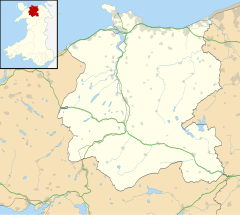Llannefydd


- Llannefydd
- Conwy
- Clwyd
- Clwyd West
- Clwyd West
Llannefydd (sometimes Welsh: Llanefydd) is a village and community in Conwy County Borough, in Wales. It is located on the border with Denbighshire, between the Afon Aled and River Elwy, 5.7 miles (9.2 km) north west of Denbigh, 5.8 miles (9.3 km) south west of St Asaph, 6.9 miles (11.1 km) south of Abergele and 15.2 miles (24.5 km) south east of Conwy. In the 2011 census the community parish had a population of 590.[1] The community includes the village of Cefn Berain and part of the hamlet of Bont Newydd.
Saint Nefydd and Saint Mary's church, founded in the fifth century,[2] is Grade I listed; the farms of Berain and Plas Uchaf are Grade II* listed, with Plas Uchaf's gardens being listed at Grade II on the Cadw/ICOMOS Register of Parks and Gardens of Special Historic Interest in Wales.[3] Numerous agricultural buildings in the community, along with a number of bridges over the two rivers, are Grade II listed.[4] In 1978, archaeological excavations in a cave at Bont-newydd, in the east of the community, unearthed the teeth and jawbone of an 11-year-old Neanderthal boy dating from 230,000 years ago, the oldest human remains discovered in Wales.[5]
Thomas Edwards, better known as the Welsh language dramatist and poet Twm o'r Nant, was born in Llannefydd in 1738, but fled to Llandeilo to avoid imprisonment for his uncle's debts, for which he had stood surety. His anterliwtau (English: interludes), satirical musical plays, lambasted tax collectors, landlords, lawyers and the religious hypocrisy of the established church, and promoted Methodism.[6]
Nearby is the hill Mynydd y Gaer which has a hillfort and is 280 metres (919 feet) with views stretching to Snowdonia, the Clwydian Range and Mynydd Hiraethog.
References
- ^ a b "Area: Llannefydd (Parish), Key Figures for 2011 Census: Key Statistics". Neighbourhood Statistics. Office for National Statistics. Retrieved 12 May 2014.
- ^ "Llannefydd: St Nefydd and St Mary". Clwyd Churches. Clwyd Family History Society. 2012. Retrieved 9 April 2013.
- ^ Cadw. "Plas Uchaf, Llannefydd (PGW(Gd)55(CON))". National Historic Assets of Wales. Retrieved 6 February 2023.
- ^ "Listed Buildings in Llannefydd, Conwy, Wales". British Listed Buildings. British Listed Buildings Online. Retrieved 9 April 2013.
- ^ "The Oldest People in Wales: Neanderthal Teeth from Pontnewydd Cave". Rhagor: Explore Our Collections. National Museum of Wales. Archived from the original on 13 June 2013. Retrieved 9 April 2013.
- ^ "Thomas Edwards". Llandeilo Through the Ages. Terry Norman. Archived from the original on 30 July 2013. Retrieved 9 April 2013.
External links
 Media related to Llannefydd at Wikimedia Commons
Media related to Llannefydd at Wikimedia Commons
- A Vision of Britain Through Time
- British Listed Buildings
- Clwyd Churches
- Eastern Conwy Churches Survey
- Genuki
- Geograph
- Office for National Statistics
- www.hill-bagging.co.uk : Mynydd y Gaer
- v
- t
- e

and villages
- Betws yn Rhos
- Betws-y-Coed
- Bylchau
- Caerhun
- Capel Curig
- Capel Garmon
- Cerrigydrudion
- Craig-y-Don
- Dinmael
- Dolgarrog
- Dolwyddelan
- Dwygyfylchi
- Eglwysbach
- Glan Conwy
- Henryd
- Llanbedr-y-Cennin
- Llanddoged
- Llanddulas
- Llanfair Talhaiarn
- Llanfihangel Glyn Myfyr
- Llangernyw
- Llangwm
- Llannefydd
- Llanrhychwyn
- Llansannan
- Llysfaen
- Maenan
- Melin-y-Coed
- Mochdre
- Pandy Tudur
- Penmachno
- Pentre Bont
- Pentrefoelas
- Rhos-on-Sea
- Rowen
- Tal-y-bont
- Tal-y-Cafn
- Trefriw
- Towyn
- Ysbyty Ifan
- Abergele
- Betws-y-Coed
- Betws yn Rhos
- Bro Garmon
- Bro Machno
- Caerhun
- Capel Curig
- Cerrigydrudion
- Colwyn Bay
- Conwy
- Dolgarrog
- Dolwyddelan
- Eglwysbach
- Henryd
- Kinmel Bay and Towyn
- Llanddoged and Maenan
- Llanddulas and Rhyd-y-foel
- Llandudno
- Llanfair Talhaiarn
- Llanfairfechan
- Llanfihangel Glyn Myfyr
- Llangernyw
- Llangwm
- Llannefydd
- Llanrwst
- Llansanffraid Glan Conwy
- Llansannan
- Llysfaen
- Mochdre
- Old Colwyn
- Penmaenmawr
- Pentrefoelas
- Rhos-on-Sea
- Trefriw
- Ysbyty Ifan
- Parliamentary constituencies
- Churches
- Places
- Schools
- Country houses
- SSSIs
- Scheduled Monuments
- Listed buildings
- Registered parks and gardens
- Lord Lieutenants
- High Sheriffs
- Museums
- Public art
- Place names
 Geography
Geography Wales
Wales
 | This Conwy County Borough location article is a stub. You can help Wikipedia by expanding it. |
- v
- t
- e













